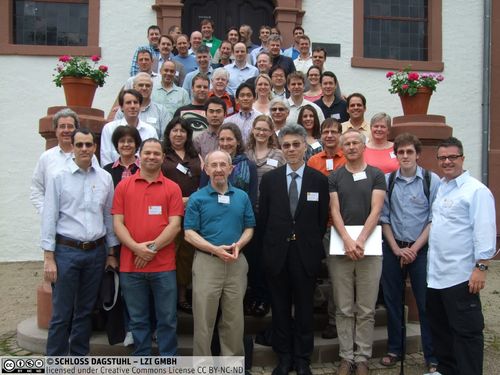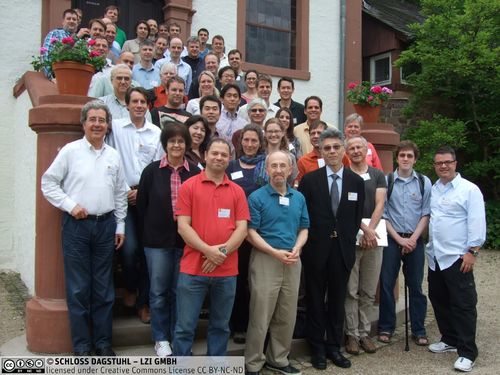Dagstuhl Seminar 13241
Virtual Realities
( Jun 09 – Jun 14, 2013 )
Permalink
Organizers
- Guido Brunnett (TU Chemnitz, DE)
- Sabine Coquillart (INRIA - Grenoble, FR)
- Robert van Liere (CWI - Amsterdam, NL)
- Gregory F. Welch (University of Central Florida - Orlando, US)
Contact
Dagstuhl Seminar Wiki
- Dagstuhl Seminar Wiki (Use personal credentials as created in DOOR to log in)
Virtual Reality (VR) is a multidisciplinary area of research aimed at interactive human computer mediated simulations of artificial environments. An important aspect of VR-based systems is the stimulation of the human senses - usually sight, sound, and touch - such that a user feels a sense of presence (or immersion) in the virtual environment. Different applications require different levels of presence, with corresponding levels of realism, sensory immersion, and interactive fidelity. Sometimes it is important to combine real and virtual objects in the same real or virtual environment. This approach is often referred to as Augmented Reality (AR), when certain virtual objects are integrated into a real environment. Typical VR applications include simulation, training, scientific visualization, and entertainment, whereas typical AR applications include computer-aided manufacturing or maintenance, and computer-aided surgery or medicine.
In the organization of this seminar we intend to experiment with varying formats of the sessions including the standard talk-and-discussion format, grand-challenge-discussions involving the whole group and parallel breakout discussions devoted to particular subjects. For this meeting we plan to solicit in advance ideas for breakout sessions and research areas for talk/discussion clusters. It is planned to publish a proceedings volume similar to the book “Virtual Realities” published by Springer in 2011.
Important topics to be discussed include:
- Multi-modal systems: The development of appropriate multi-modal devices (projection walls, head mounted displays, data gloves, force feedback arms, spatialized audio, etc.) in order to deliver multi-modal signals into the human sensory system is a basic aspect of VR technology. The fidelity and degree of immersion of these systems is a crucial factor in any user-perceived sense of presence.
- 3D interaction: For a sense of presence to be sustained, it is necessary that the objects of the virtual world appropriately react to the actions of the user. Some primary challenges in this context include the real-time tracking of the user's movements, and the design of intuitive devices for the user to control the virtual environment. In particular, many problems remain in the realization of VR systems that simultaneously support multiple users.
- Presence, Telepresence and Tele-existence: The understanding of different aspects of presence and the appropriate technical means to induce this experience remains a hot topic in VR. As an example it has recently been suggested that “presence” should really be considered in two parts: a place illusion (a sense of being in a place) and a plausibility illusion (a sense that something is really happening). These theoretical constructs also apply for telepresence and teleexistence in terms of how much real people perceive the presence of a remote virtual participant, and how the remote participant perceives a sense of presence with the real people.
- Virtual humans: Autonomous avatars are now becoming practical, offering the promise of a controlled human dimension to applications such as education, training, and entertainment. As such researchers are now in a position to explore fundamental questions related to virtual humans.
Virtual Reality (VR) is a multidisciplinary area of research aimed at interactive human computer mediated simulations of artificial environments. An important aspect of VR-based systems is the stimulation of the human senses - usually sight, sound, and touch - such that a user feels a sense of presence in the virtual environment. Sometimes it is important to combine real and virtual objects in the same real or virtual environment. This approach is often referred to as Augmented Reality (AR), when virtual objects are integrated into a real environment. Research in VR and AR encompasses a wide range of fundamental topics, including: 3D interaction, presence, telepresence and tele-existence, VR modelling, multi-model systems, and human factors. Typical VR applications include simulation, training, scientific visualization, and entertainment, whereas typical AR applications include computer-aided manufacturing or maintenance, and computer-aided surgery or medicine.
The main goal of the seminar was to bring together leading international experts and promising young researchers to discuss current VR and AR challenges and future directions.
The organization built on the experiences from the previous seminar "Virtual Realities 2008". The format of the seminar included sessions with standard presentations as well as parallel breakout sessions devoted to "hot-topics" in VR and AR research. It was the desire of the participants of the seminar that sufficient time for plenary discussion and working groups was scheduled. Before the seminar, the organizers solicited topics for the working groups. During the first days of the seminar these working groups were formed and a schedule was created. Plenary sessions were also scheduled to allow the working groups to report and discuss their findings.
Eight plenary sessions of presentations were scheduled throughout the week. Each session usually consisted of three 15 minute presentations followed by a 45 minute moderated discussion. Abstracts of the presentations are collected in the next chapter. The Monday afternoon plenary sessions were devoted to the topics of Telepresence and Human Embodiment. Tuesday morning the topics Applications and Health/Wellbeing were presented. Wednesday morning was devoted to a session on Virtual Environments. The Thursday morning sessions were on Commercial/Buisiness aspects of VR and Authoring/ Content. The last session was devoted to Augmented Reality.
Seven working groups were created and parallel breakout sessions held throughout the week. Each working group reported their findings in plenary sessions. The following lists the titles of the working groups:
- Real Time Interactive Systems - Architecture Issues
- VR Current State and Challenges
- 3D User Interfaces
- Avatars in Virtual Reality
- Scientific Visualization and VR
- Characterising Interactions in Virtual (and/or Real) Environments
- Unconventional Mixed Environments
 Guido Brunnett, Sabine Coquillart, Robert van Liere, and Gregory F. Welch
Guido Brunnett, Sabine Coquillart, Robert van Liere, and Gregory F. Welch
- Carlos Andujar (UPC - Barcelona, ES) [dblp]
- Steffi Beckhaus (Eppstein, DE) [dblp]
- Roland Blach (FhG IAO - Stuttgart, DE) [dblp]
- Wolfgang Broll (TU Ilmenau, DE) [dblp]
- Pere Brunet (UPC - Barcelona, ES) [dblp]
- Guido Brunnett (TU Chemnitz, DE) [dblp]
- Sabine Coquillart (INRIA - Grenoble, FR) [dblp]
- Carolina Cruz-Neira (University of Louisiana at Lafayette, US) [dblp]
- Ralf Dörner (Hochschule RheinMain - Wiesbaden, DE) [dblp]
- Steven K. Feiner (Columbia University, US) [dblp]
- Uwe Freiherr von Lukas (FhG IGD - Rostock, DE) [dblp]
- Bernd Fröhlich (Bauhaus-Universität Weimar, DE) [dblp]
- Henry Fuchs (University of North Carolina at Chapel Hill, US) [dblp]
- Martin Göbel (FH Bonn-Rhein-Sieg, DE) [dblp]
- Raphael Grasset (TU Graz, AT) [dblp]
- Jens Herder (FH Düsseldorf, DE) [dblp]
- Tobias Höllerer (University of California - Santa Barbara, US) [dblp]
- Charles E. Hughes (University of Central Florida - Orlando, US) [dblp]
- Masahiko Inami (Keio University - Yokohama, JP) [dblp]
- Victoria Interrante (University of Minnesota - Minneapolis, US) [dblp]
- Bernhard Jung (TU Bergakademie Freiberg, DE) [dblp]
- Panagiotis Kaklis (National Technical University of Athens, GR) [dblp]
- Marcelo Kallmann (University of California - Merced, US) [dblp]
- Yoshifumi Kitamura (Tohoku University, JP) [dblp]
- Kiyoshi Kiyokawa (Osaka University, JP) [dblp]
- Gudrun Klinker (TU München, DE) [dblp]
- Ernst Kruijff (FH Bonn-Rhein-Sieg, DE) [dblp]
- Torsten Kuhlen (RWTH Aachen, DE) [dblp]
- Marc Erich Latoschik (Universität Würzburg, DE) [dblp]
- Anatole Lecuyer (INRIA Rennes - Bretagne Atlantique, FR) [dblp]
- Robert W. Lindeman (Worcester Polytechnic Institute, US) [dblp]
- Paul Milgram (University of Toronto, CA) [dblp]
- Mark Mine (Walt Disney Imagineering, US) [dblp]
- Betty Mohler (MPI für biologische Kybernetik - Tübingen, DE) [dblp]
- Tabitha C. Peck (Duke University - Durham, US) [dblp]
- Jerome Perret (Haption - Aachen, DE) [dblp]
- John Quarles (The University of Texas - San Antonio, US) [dblp]
- Christian Sandor (University of South Australia - Mawson Lakes, AU) [dblp]
- Dieter Schmalstieg (TU Graz, AT) [dblp]
- Andreas Simon (FH Nordwestschweiz, CH) [dblp]
- Oliver Staadt (Universität Rostock, DE) [dblp]
- Anthony Steed (University College London, GB) [dblp]
- Jeanine Stefanucci (University of Utah, US) [dblp]
- Frank Steinicke (Universität Würzburg, DE) [dblp]
- Susumu Tachi (Keio University - Yokohama, JP) [dblp]
- Robert van Liere (CWI - Amsterdam, NL) [dblp]
- Gregory F. Welch (University of Central Florida - Orlando, US) [dblp]
- Gabriel Zachmann (Universität Bremen, DE) [dblp]
Related Seminars
- Dagstuhl Seminar 08231: Virtual Realities (2008-06-01 - 2008-06-06) (Details)
Classification
- Computer Graphics/Computer Vision
- Multimedia
- Society/HCI
Keywords
- Virtual
- Augmented and Mixed Reality
- Presence
- Telepresence and Tele-existence
- Avatars
- Human Motion
- 3D user interfaces



 Creative Commons BY 3.0 Unported license
Creative Commons BY 3.0 Unported license
